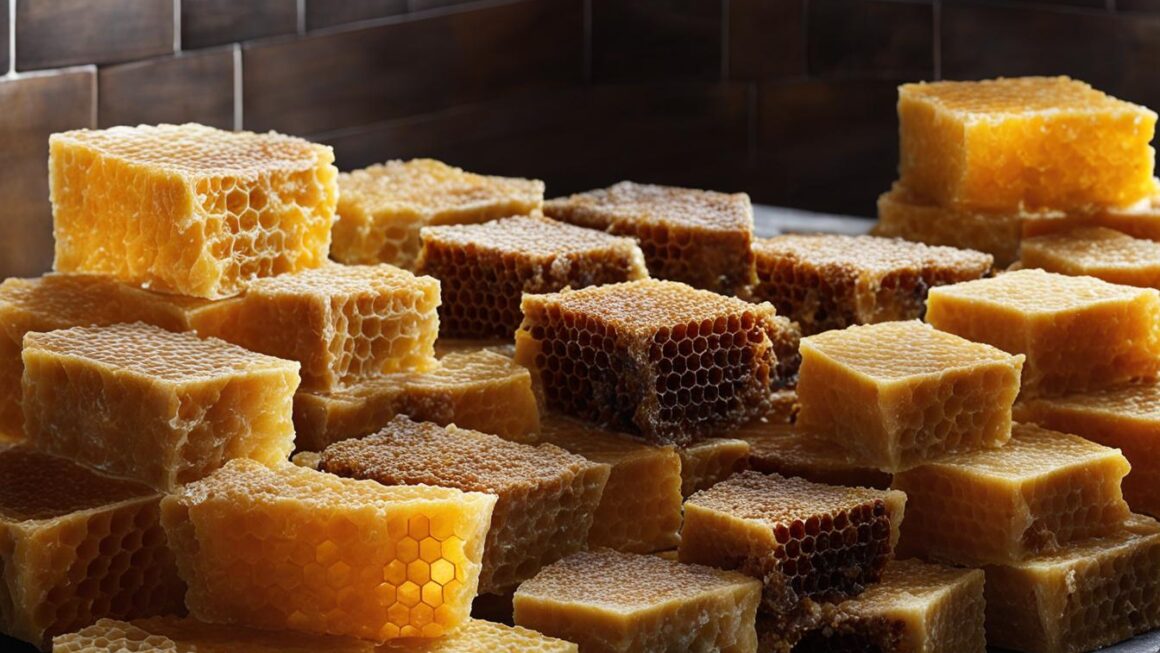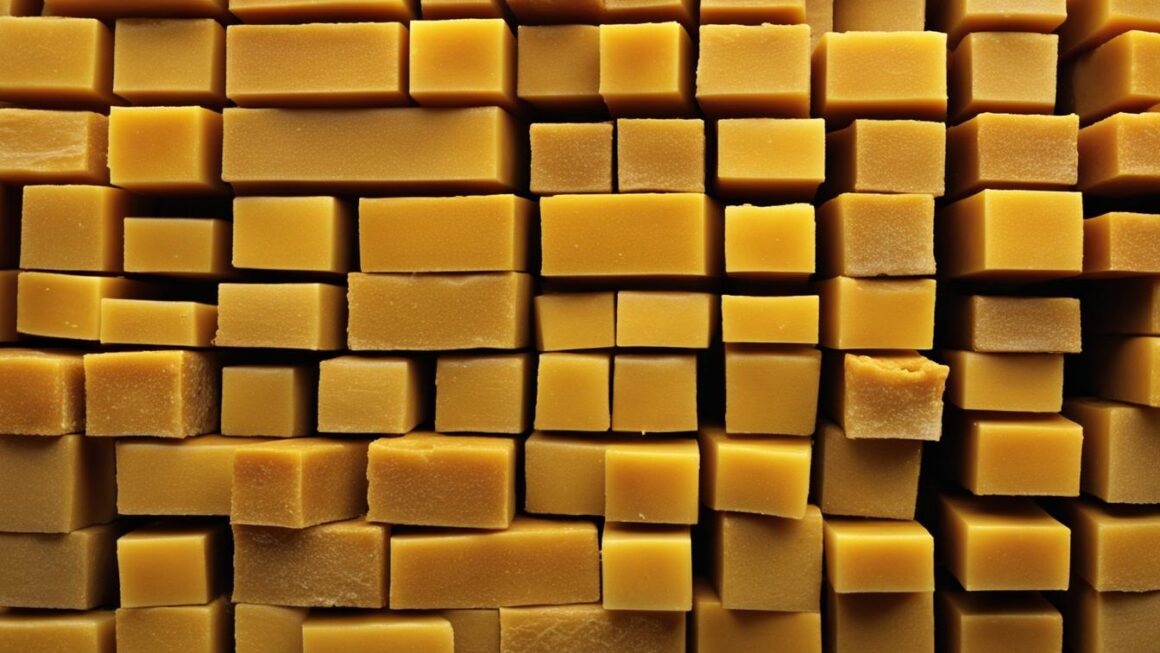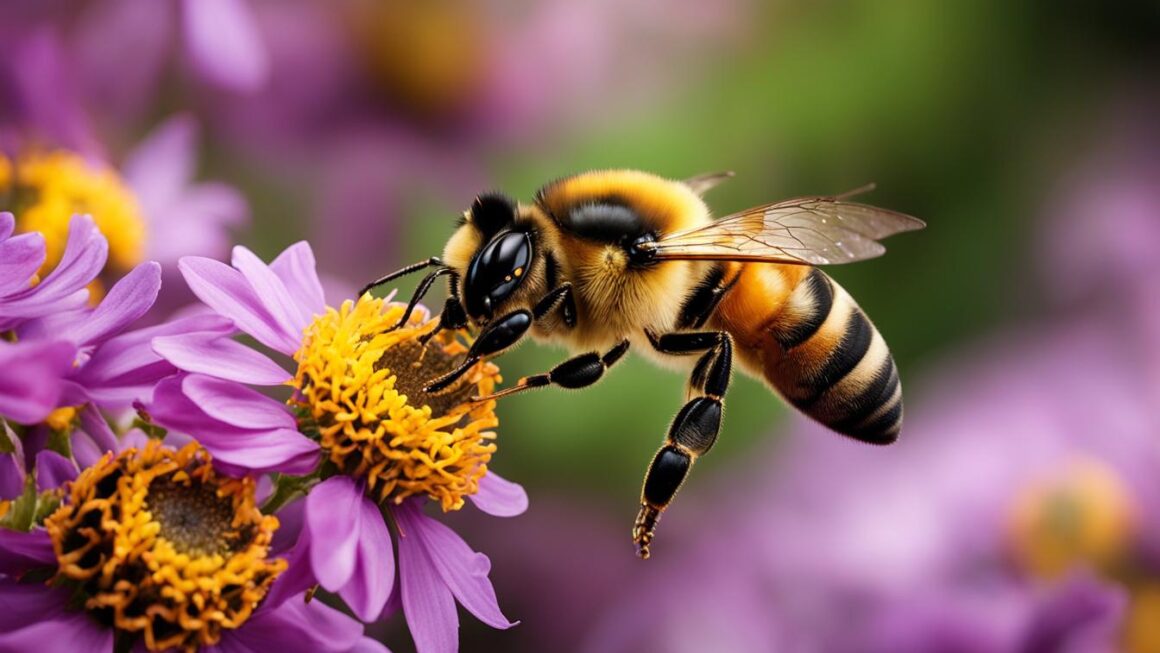Honeycomb is a traditional way to enjoy honey, but it can be more expensive. Knowing how to store honeycomb is essential to prevent waste and save money. Honeycomb can be stored in an airtight container at room temperature to protect it from moisture. It is not necessary to refrigerate opened honeycomb, as it can increase the rate of crystallization. Freezing is the best long-term storage option for larger amounts of honeycomb, but it is important to wrap it tightly to prevent moisture absorption.
Key Takeaways:
- Store honeycomb in an airtight container at room temperature to protect it from moisture.
- Avoid refrigerating opened honeycomb to prevent crystallization.
- For long-term storage, wrap honeycomb tightly and freeze it.
- Proper storage helps prevent waste and saves money.
- Knowing how to store honeycomb ensures optimal freshness and longevity.
Where Does Honeycomb Come From?
Honeycomb is a fascinating creation that comes from the hard work of honey bees. These small insects build hexagonal cells made of beeswax to create their home, known as the honeycomb. The bees use these cells to raise their young and store food for the winter. They gather plant nectar and transform it into honey, which is then stored in the cells of the honeycomb. This process is a remarkable display of nature’s ingenuity and the intricate cooperation within a bee colony.
Comb honey, also known as sections of comb, is honey in its purest form. In the past, it was the only way to buy fresh honey. Beekeepers carefully extract liquid honey from the comb using honey extractors, leaving behind empty comb that can be reused by the bees. It’s a sustainable cycle that allows beekeepers to continue harvesting honeycomb while providing the bees with a home and a vital food source.
Honeycomb is not only a delicious treat but also a symbol of the incredible capabilities of honey bees. By understanding where honeycomb comes from and the efforts involved in its creation, we can appreciate the value of this natural wonder.
The Process of Honeycomb Creation
To gain a deeper understanding of honeycomb’s origin, let’s delve into the fascinating process undertaken by honey bees to create this remarkable structure. It all starts with worker bees collecting nectar from flowers. They suck up the nectar using their long proboscis and store it in their honey stomachs. Enzymes in the stomach begin to convert the nectar into honey.
Once back at the hive, worker bees regurgitate the partially processed nectar into the mouth of other worker bees. This process, known as trophallaxis, helps to spread enzymes and beneficial gut bacteria throughout the hive. The worker bees then deposit the partially processed nectar into the hexagonal cells of the honeycomb, where it continues to ripen into honey over time.
During this process, the bees secrete beeswax from special glands on their abdomens. They mold the wax into the hexagonal shape of the honeycomb cells, using their bodies and jaws to shape and polish the wax. As the honeycomb cells are filled with honey, the bees cap them with a layer of beeswax to seal it off and protect it from moisture and contaminants. This sealed honeycomb can be stored for long periods, providing the bees with a valuable food source in times of scarcity.
The Role of Beekeepers
Beekeepers play a crucial role in the production and harvesting of honeycomb. They carefully manage and maintain honey bee colonies, providing the bees with suitable hives and ensuring they have access to abundant nectar sources. Beekeepers regularly monitor the health and well-being of the bees, taking necessary steps to prevent diseases and pests.
When the time comes to harvest honeycomb, beekeepers use various methods to remove the comb from the hive without harming the bees. They may cut sections of comb or use special frames designed to hold honeycomb. Beekeepers follow strict protocols to ensure the quality and purity of the honeycomb, allowing us to enjoy this natural delicacy.
The Economic Advantage of Harvesting Honey in the Comb
Honey production is a labor-intensive process that involves careful management and attention to detail. Beekeepers face the decision of whether to extract honey from the comb or harvest it in its natural form, known as honey in the comb. While harvesting honey in the comb may require more effort and resources, it offers several economic advantages for beekeepers.
When honey is harvested in the comb, it requires the production of more beeswax before the next harvest. This means that less liquid honey is produced, reducing the overall quantity of honey available for sale. However, the experience of eating honeycomb is highly valued by consumers, and honeycomb itself is a sought-after product. The unique texture and flavor of honey in the comb make it a premium option for those seeking a more natural and authentic honey experience.
Furthermore, honeycomb has an unlimited shelf-life as long as it is protected from moisture. It does not spoil and can be stored for extended periods without any loss of quality. This means that beekeepers can stockpile honeycomb during periods of high production and sell it throughout the year. This can be particularly advantageous during periods when liquid honey production may be low, such as during winter months or when nectar sources are scarce.
Overall, while harvesting honey in the comb may require additional resources and result in less liquid honey production, it offers an economic advantage for beekeepers. The demand for honeycomb remains high among consumers who appreciate its unique qualities, and its extended shelf-life allows beekeepers to ensure a steady supply of honey throughout the year.
The Economic Advantage of Harvesting Honey in the Comb
| Advantages | Disadvantages |
|---|---|
| Higher demand among consumers | Less liquid honey production |
| Unique texture and flavor | Requires more beeswax production |
| Extended shelf-life | Increased storage space needed |
(Table: Advantages and Disadvantages of Harvesting Honey in the Comb)
Storing Honey Supers Over Winter
Beekeepers face the challenge of storing honey supers, drawn comb, and other equipment associated with honey production during the winter months. Honey supers, which collect honey for the beekeeper, are removed from the hive once the honey harvesting season is over. Storing honey supers with drawn comb requires a safe place to prevent wax moth infestations. Drawn comb frames are valuable and should be stored properly to protect them from pests.
There are several options for storing honey supers over winter:
- Freezing: Freezing honey supers is a common method to prevent wax moth infestations. Wrap the honey supers tightly in plastic or place them in sealed containers before freezing. This method ensures that any wax moth larvae or eggs are killed during the freezing process. When thawing the honey supers, make sure to remove any condensation that may have formed to prevent moisture damage.
- Open Shed: Storing honey supers in an open shed with light and air circulation can also be effective. This method allows the beeswax to naturally air out and helps prevent moisture buildup that can attract pests. However, it’s important to ensure that the shed is secure and protected from rodents and other animals that may cause damage.
- Chemical Protection: Some beekeepers use chemical methods to protect honey supers from pests. This can include using products specifically designed to repel wax moths or other pests. It’s important to follow the instructions provided by the manufacturer and ensure that any chemicals used are safe for both the bees and the honey.
By employing these storage tips, beekeepers can ensure that their honey supers, drawn comb, and other beekeeping equipment are protected during the winter months. Proper storage is essential for maintaining the quality and integrity of the honey and beeswax, allowing beekeepers to continue producing honey of the highest standard.
| Storage Method | Advantages | Disadvantages |
|---|---|---|
| Freezing | – Kills wax moth larvae and eggs – Prevents infestations – Easy to implement |
– Requires space in a freezer – May cause condensation during thawing |
| Open Shed | – Allows natural air circulation – Prevents moisture buildup |
– Requires a secure shed – Risk of exposure to pests |
| Chemical Protection | – Repels pests – Offers targeted protection |
– Requires careful application – Potential impact on bees and honey |
Freezing Honeycomb for Long-Term Storage
Honeycomb can be effectively stored for long periods of time by utilizing the method of freezing. Freezing honeycomb helps to preserve its quality and prevent spoilage. To freeze honeycomb, it is important to follow a few essential steps:
- Start by tightly wrapping the honeycomb in several layers of plastic wrap. This helps to protect it from moisture and keep it in good condition during the freezing process.
- Place the wrapped honeycomb in an airtight freezer container. This provides an additional layer of protection against freezer burn and contamination.
- When thawing frozen honeycomb, it is best to allow it to come to room temperature gradually. This can be done by placing it on a cooling rack and leaving it there until fully thawed.
- After thawing, it is important to check the honeycomb for any excess liquid. If there is any, gently blot it with a paper towel to remove the moisture.
- For optimal storage, it is recommended to keep the honeycomb submerged in a container with liquid honey. This helps to prevent the wax edges from drying out and maintains the overall quality of the honeycomb.
By following these freezing methods, honeycomb can be stored for extended periods of time while maintaining its freshness and flavor.
Best Practices for Honeycomb Storage
Proper storage of honeycomb is essential to maintain its quality and freshness. Follow these best practices to ensure the longevity of your honeycomb:
Protect from Moisture
Honeycomb absorbs moisture easily, which can affect its texture and quality. To prevent moisture absorption, store honeycomb in an airtight container. Make sure the container is completely sealed to keep the honeycomb dry. Moisture can lead to crystallization and a gritty texture, so it’s important to protect your honeycomb from any contact with water.
Room Temperature Storage
Storing honeycomb at room temperature is generally recommended. Refrigeration can accelerate crystallization, resulting in a gritty texture. However, if you prefer a smoother texture, you can refrigerate honeycomb without ruining it. Just be aware that refrigeration may change the texture slightly.
Long-Term Storage
If you have a large amount of honeycomb that you want to store for an extended period, freezing is the best option. Wrap the honeycomb tightly in several layers of plastic wrap or place it in an airtight freezer container. Freezing helps preserve the honeycomb’s freshness and prevents moisture absorption. When you’re ready to use the frozen honeycomb, allow it to thaw at room temperature and ensure that all individual cells are sealed with wax to prevent leakage.
Remember to always store honeycomb in a cool, dry place away from light and moisture to maintain its quality.
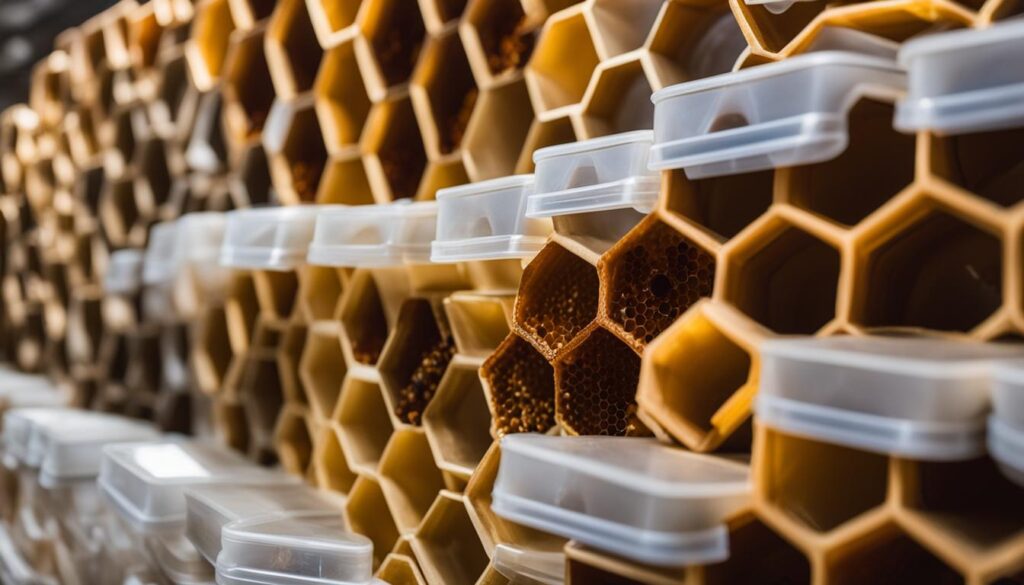
The Best Containers for Honey Storage
Proper storage containers are essential for preserving the freshness and quality of honey. When it comes to storing honey, it is important to choose containers that are food-safe, airtight, and capable of protecting the honey from light and moisture. The following are some of the best containers for honey storage:
- Glass Containers: Mason jars made of glass are a popular choice for honey storage. They are not only visually appealing, but also allow you to see the honey and monitor its crystallization. Glass containers are non-reactive and do not alter the taste or quality of the honey.
- Plastic Containers: Food-safe plastic containers are another option for storing honey. Look for containers that are specifically designed for food storage and are labeled as BPA-free. Plastic containers are lightweight and convenient for transporting honey.
Before storing honey, make sure that the containers are clean and dry to prevent any contamination. It is also important to protect stored honey from light exposure, as it can cause the honey to darken. Keep in mind that metal containers are not recommended for long-term honey storage, as they can cause oxidation and give the honey a metallic taste.
Choose the right containers for honey storage to ensure that your honey remains fresh and delicious for as long as possible.
Preventing Honey Crystallization
To maintain the smooth consistency of honey and prevent crystallization, it’s important to store it at room temperature. Crystallization occurs when the sugar molecules in honey align and form crystals. By keeping honey at room temperature, the sugars remain dissolved, preventing the formation of large crystals.
Low temperatures can accelerate the crystallization process, resulting in the formation of large crystals that settle at the bottom of the container. However, it’s crucial to note that crystallized honey is still safe to eat and can be returned to its liquid state with gentle warming.
To store honey and prevent crystallization, it’s best to keep it in a dark and dry place away from direct sunlight. Light exposure can cause darkening of the honey and potentially affect its flavor. Additionally, honey should be protected from moisture, as it can alter the texture and quality of the honey.
Preventative Measures for Honey Crystallization:
- Store honey at room temperature to keep the sugars dissolved.
- Avoid refrigerating honey, as it can accelerate crystallization.
- Protect honey from moisture to maintain its texture and quality.
- Store honey in a dark and dry place away from light exposure.
- Warm crystallized honey gently to return it to its liquid state.
Did You Know? Crystallized honey can be used to make creamed honey by gently stirring it to promote a fine and smooth crystalline structure throughout the entire jar. This results in a creamy and spreadable consistency that many people enjoy.
Honey Consistency and Sugar Molecules
The consistency of honey is influenced by the ratio of sugars present in the honey, particularly glucose and fructose. Different types of honey may have varying ratios, resulting in differences in texture and crystallization tendencies.
Glucose is more prone to crystallization compared to fructose. When the glucose concentration in honey increases, the likelihood of crystallization also increases. The presence of other factors such as pollen, minerals, and temperature can further affect the crystallization process.
| Type of Honey | Glucose-to-Fructose Ratio | Crystallization Tendency |
|---|---|---|
| Acacia Honey | 1:2 | Low |
| Clover Honey | 1:1.2 | Moderate |
| Manuka Honey | 1:1.3 | High |
As shown in the table above, honey varieties with higher glucose-to-fructose ratios have a higher tendency to crystallize. However, it’s important to note that the crystallization process does not indicate spoilage or a decrease in quality. With proper storage and gentle warming, crystallized honey can be restored to its liquid state, allowing you to continue enjoying its sweet goodness.
How to Store Honey in Honeycomb
Storing honey in honeycomb is a simple and effective way to preserve its freshness and enjoy its natural flavors. When it comes to honey extraction, removing the honeycomb from the beehive frames and cutting it into sections is the first step. To ensure proper storage, it is important to protect the honeycomb from moisture, light, and temperature fluctuations.
One method of storing honey in honeycomb is by tightly wrapping it in plastic. This helps to keep the honeycomb free from exposure to air and prevents moisture absorption. Alternatively, sealed containers can also be used to store honeycomb, ensuring airtight protection. The choice of wrapping material or container should prioritize maintaining a cool, dry environment to prevent spoilage.
Another storage method for honeycomb is freezing. Freezing honeycomb helps to extend its shelf life and preserve its natural qualities. To thaw frozen honeycomb, it is recommended to use indirect heat, such as placing it in warm water. This gradual thawing process helps to retain the integrity of the honeycomb and prevent any nutrient loss.
Overall, proper storage methods for honeycomb involve protecting it from moisture, light, and temperature fluctuations. Whether it’s wrapping in plastic, using sealed containers, or freezing, the goal is to maintain optimal freshness and longevity. By storing honey in honeycomb correctly, you can enjoy the rich and distinct flavors of honey for an extended period.
Honeycomb Storage Methods
Here are some recommended honeycomb storage methods:
- Plastic Wrapping: Tightly wrap honeycomb in plastic to protect it from moisture and air exposure.
- Sealed Containers: Store honeycomb in airtight containers to prevent spoilage and maintain freshness.
- Freezing: Freeze honeycomb to extend its shelf life and preserve its natural qualities.
Summary:
Storing honey in honeycomb involves removing it from the beehive frames and protecting it from moisture, light, and temperature fluctuations. Honeycomb can be wrapped in plastic or stored in sealed containers to ensure airtight protection. Freezing honeycomb is another effective storage method. By following these storage methods, you can maintain the freshness and enjoy the natural flavors of honey for a longer period.
Table: Honeycomb Storage Methods
| Storage Method | Advantages | Disadvantages |
|---|---|---|
| Plastic Wrapping | Protects honeycomb from moisture and air exposure | May require additional wrapping layers for optimal protection |
| Sealed Containers | Prevents spoilage and maintains freshness | Containers must be airtight for effective storage |
| Freezing | Extends shelf life and preserves natural qualities | Requires gradual thawing to prevent nutrient loss |
Problems with Honey Crystallization
Honey crystallization is a natural process that occurs when the sugars in honey form crystals. This can lead to some challenges in using crystallized honey, such as the formation of large crystals that settle at the bottom of the container. These large crystals can make the honey thick and difficult to spread or use. However, crystallized honey can still be enjoyed by gently warming it to return it to its liquid state.
Another type of crystallization is the formation of small crystals that remain suspended in the honey, creating what is known as creamed honey. Creamed honey has a smooth and spreadable consistency, making it a popular choice for many honey lovers. It can be used as a topping for toast, pancakes, or even added to recipes for a touch of natural sweetness.
Crystallized honey can be difficult to use, as it becomes thick and sticky. Thawing out crystallized honey should be done gently to avoid nutrient loss.
When storing honey, it’s important to note that low temperatures can accelerate the crystallization process. To prevent crystallization or slow it down, it is recommended to store honey at room temperature. This helps to keep the sugars dissolved and prevents the formation of large crystals. Storing honey in a dark and dry place away from sunlight is also important to maintain its quality and prevent darkening.
In summary, honey crystallization is a natural occurrence that can lead to the formation of large or small crystals in honey. While this can present some challenges in using crystallized honey, it can still be enjoyed by gently warming it or as creamed honey. By storing honey at room temperature and protecting it from light exposure, you can help prevent or slow down the crystallization process and maintain the quality of your honey.
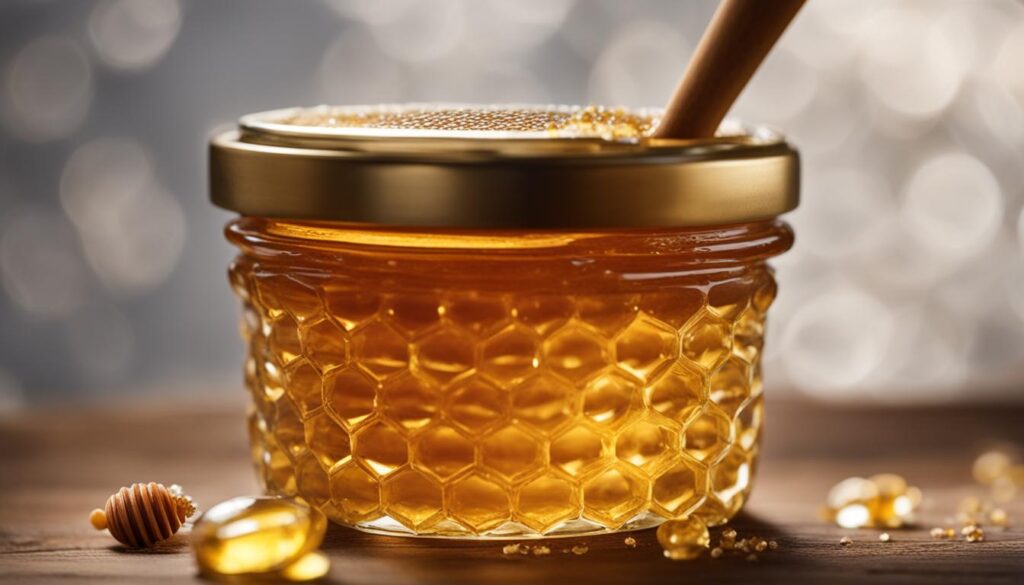
Conclusion
Proper storage is crucial for maintaining the optimal freshness and longevity of honeycomb. Storing honeycomb in an airtight container at room temperature is the best way to protect it from moisture and preserve its quality. Avoid refrigerating opened honeycomb to prevent increased crystallization.
For long-term storage of larger quantities, freezing honeycomb is recommended. Wrap it tightly in multiple layers of plastic wrap or use an airtight freezer container to prevent moisture absorption. Thaw frozen honeycomb at room temperature, ensuring all cells are sealed with wax to avoid leakage.
By choosing the right storage containers, protecting honeycomb from light exposure, and preventing crystallization, you can enjoy the delicious taste of honeycomb for an extended period. Remember to store honeycomb in a cool, dry place away from moisture. Follow these honeycomb storage tips to ensure optimal freshness and longevity of this cherished natural delicacy.
FAQ
How should honeycomb be stored?
Honeycomb should be stored in an airtight container at room temperature to protect it from moisture.
Is it necessary to refrigerate opened honeycomb?
No, it is not necessary to refrigerate opened honeycomb as it can increase the rate of crystallization.
What is the best long-term storage option for honeycomb?
Freezing is the best long-term storage option for larger amounts of honeycomb. It should be tightly wrapped to prevent moisture absorption.
How is honeycomb produced?
Honeycomb is produced by honey bees using beeswax to create hexagonal cells, which are used to raise young bees and store food for the winter.
What is the economic advantage of harvesting honey in the comb?
Harvesting honey in the comb requires more beeswax production, resulting in less liquid honey. However, the experience of eating honeycomb is worth it for many.
How should honey supers be stored during winter?
Honey supers can be stored by freezing, storing in an open shed with light and air, or using chemical protection methods to prevent wax moth infestations.
How should honeycomb be frozen?
To freeze honeycomb, wrap it tightly in several layers of plastic wrap or place it in an airtight freezer container. Thaw it at room temperature before using.
What is the best way to store honeycomb?
The best way to store honeycomb is by keeping it in an airtight container at room temperature, protecting it from moisture and sweet-loving ants.
What are the best containers for honey storage?
Honey should be stored in food-safe plastic or glass containers. Mason jars made of glass are a popular choice as they allow you to see the honey and monitor crystallization.
How can honey crystallization be prevented?
Honey should be stored at room temperature to prevent crystallization. Low temperatures can accelerate the process. Gentle warming can return crystallized honey to its liquid state.
How can honey be stored in honeycomb?
Honeycomb can be stored by removing it from beehive frames and cutting it into sections. It can be tightly wrapped or stored in sealed containers.
What are the problems with honey crystallization?
Honey crystallization can result in large crystals settling at the bottom or small crystals suspended in the honey, creating creamed honey.

